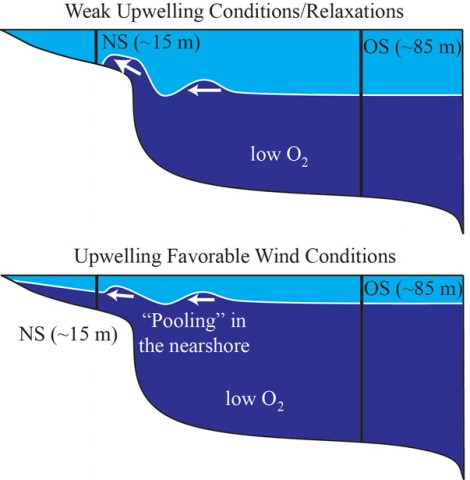
Ryan Walter
In the coastal ocean, internal waves that break on the continental shelf can send pulses of water, known as bores, into the shallows. These internal bores can cause dramatic and rapid changes in the density of the water and the concentration of dissolved oxygen when they transport cold, low-oxygen waters from the deeper parts of the ocean into the nearshore coastal environment. Such a rapid, shock-like decrease in oxygen concentration can have serious ecological consequences.
Although previous research suggested that internal bores are modified by changing conditions farther offshore, little work has been done in the field at a high enough spatial and temporal resolution to sort out the connection. Likewise, much of the research on internal waves and bores in shallow waters has been numerical or laboratory work conducted under idealized conditions and has focused on isolated processes.
Using observations made in Monterey Bay, California, during the summer of 2012, Walter et al. assessed how changes in wind-driven upwelling and offshore stratification affect the strength and structure of nearshore internal bores and oxygen dynamics in shallow nearshore waters.
They found that during periods of weak upwelling the offshore thermocline deepened, driving a stronger offshore internal tide and strengthening nearshore internal bores. In contrast, strong upwelling led the offshore thermocline to rise toward the surface, resulting in a pooling of cold, low-oxygen waters in the nearshore and a decrease in nearshore internal bores.
The authors found that although extended upwelling conditions are known to produce longer-duration low-oxygen events, the shock-like decreases in dissolved oxygen caused by individual bores can drive oxygen concentrations to levels low enough that they would be physiologically stressful for marine organisms. They suggest that bores should be considered in future studies of nearshore hypoxia. (Journal of Geophysical Research: Oceans, doi:10.1002/2014JC009998, 2014)
—Colin Schultz, Writer
© 2014. American Geophysical Union. All rights reserved.
© 2014. American Geophysical Union. All rights reserved.
